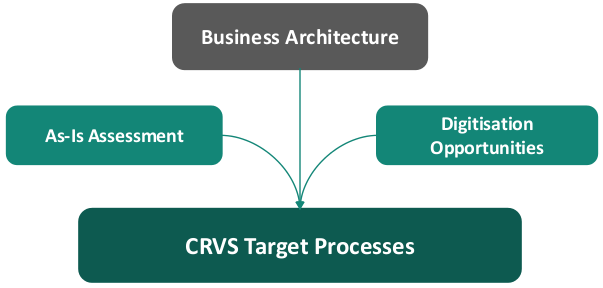Overview
Target CRVS processes are re-defined processes that respond directly to the weaknesses identified in the As-Is Assessment and the opportunities identified in the previous activity. The target processes should simplify and streamline existing processes i.e. reducing bureaucracy, facilitating the decentralisation of civil registration and improving service provision to citizens. The target processes will be supported by the Target System Architecture which enables simplification and automation.

CRVS Target Processes
Steps:
1
Use a business process modelling tool to document your target CRVS processes.
- Use the Generic CRVS Process Description in the CRVS Business Process Modelling Guide to ensure that key components of a vital event process are included in the documentation and description of your high-level processes.
- Refer to the To-Be Country CRVS Business Process Examples to see how other countries have completed this activity.
2
Identify and understand the implications of the target CRVS processes on Human Resources and define staffing requirements and new roles and responsibilities of implicated actors.
3
Define legal and policy changes required as a result of the newly defined CRVS processes and use of technology, considering the items included in the table below.
| Area for consideration |
Reason |
Consider |
|
Legal Framework
|
To understand if the digital CRVS system and processes are supported within the legal framework
|
- Are digital records legally recognised?
- Is an interim paper-based process required?
- Which authorities/individuals are permitted to capture data? If new actors have been proposed to capture data through mobile devices is this legal?
- Can digital signatures be used (if relevant)?
- What are the implications of the base legal framework in-country towards the system to support the system?
- What anti-discrimination provisions are in place?
|
|
Personal data privacy
|
To understand if citizens’ personal data is safe and protected in the digital CRVS system
|
- What data protection laws exist to cover security, privacy and confidentiality? Are they effective?
- What provisions are made in law for the incorrect use of electronic data?
- What provisions are made in law for data rights and ownership?
- What anti-surveillance provisions are in place?
|
Legal Considerations
4
Review CRVS Target Processes with relevant stakeholders as per the RACI Matrix defined in your Project implementation Document.




